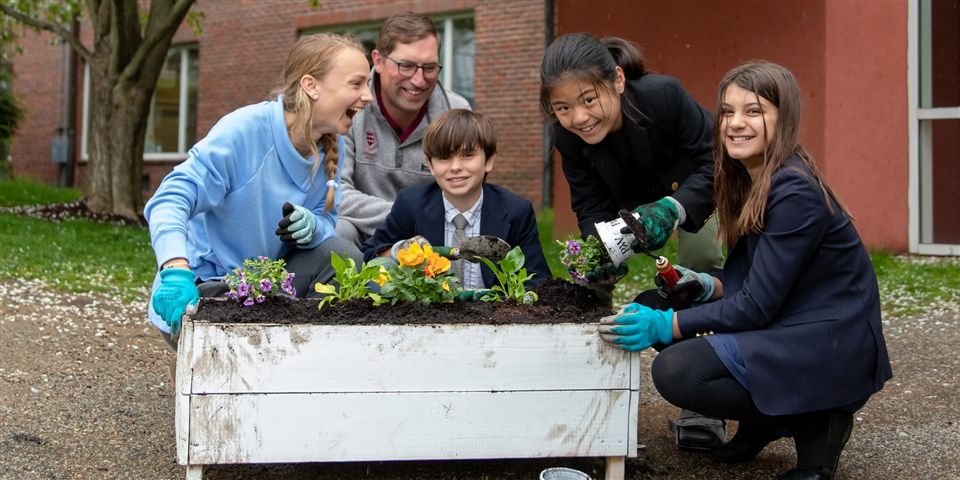News Detail - Magazine

Lower School Science: Designing Green Spaces
In a cross-disciplinary initiative to renew green spaces at Fay, fourth grade scientists have been learning about the importance of green spaces to our environment.
Science, art, and design thinking were all part of the mix this spring as fourth graders expanded their understanding of cellular biology and explored concepts of environmental justice.
During the winter term, fourth graders were immersed in cellular biology as they studied cells under a microscope, learned about the functions of each part of a cell, and experimented with photosynthesis by growing beans under a variety of conditions in the Fay greenhouse. By spring, students were ready to build on that foundational knowledge and learn about sustainability and environmental justice. While Fay is fortunate to be surrounded by abundant green space, there is a disparity between the availability of green spaces in high- and low- income areas. Students analyzed maps showing income versus green space to better understand that challenge. Fourth grade science teacher Grace Crowell introduced students to innovative examples of sustainable urban green spaces, such as Little Island in New York City, a manufactured botanical garden built on the remains of Pier 54 in the Hudson River.
Students also explored the impact of renewable energy on green spaces by designing and building their own renewable energy resources and working with kits to build wind turbines, hydroelectric turbines, solar cars, and ovens.
As they turned their attention to opportunities on the Fay campus, students worked with design teacher Lisa Sanderson to tap into the design thinking process by gathering information and ideating solutions. Students conducted stakeholder interviews with Head of School Rob Gustavson and Director of the Educational Program Julie Porrazzo, asking questions about green spaces at Fay, how green spaces can be used, and what the administration sees as opportunities to expand green spaces on campus. Students toured campus with Director of Grounds Andrew Carlisle, who showed them some of the unused spaces around campus, explained Fay’s composting system, and described the work that has been done to document and tag trees on campus.
With research finished, students started sketching their ideas. Design teacher Andrew Shirley explained the difference between a bird’s-eye plan and a zoomed-in perspective drawing, as students were required to create both. To ensure that their design accommodated the scale of existing structures and landscape features, students visited sites on campus to take measurements that they would incorporate into their design. Art teacher Jane McGinty encouraged students to think about their plans through the lens of color and placement as they incorporated annuals and perennial plantings into their designs.
Each student recreated their design in Makers Empire 3D, a modeling program designed for younger students. “Some kids really figured it out,” says Grace, noting that one of her students got so into the program that he created 133 different designs! Students generated a range of ideas: rooftop gardens on the Root Building, a natural amphitheater where students could practice their speeches, shrubs placed next to walkways to protect the lawn from pedestrian traffic, and even a moose-shaped topiary! Andrew Shirley helped students print miniature versions of their designs on the 3D printer.
The final design—raised planters outside the Picardi Art Center and greenhouse entrances—incorporated elements from various designs. While Grace worked with her dad to build the planters, fourth graders made compost sifters in the iLab under the supervision of Andrew Shirley and Andrew Carlisle. Students prepared each planter with a base of leaves gathered from around campus and fresh compost that they sifted themselves. Students even went on a worm scavenger hunt to ensure that each planter had sufficient worms to assist with aerating and improving the soil. Students filled the planters with the bean plants they had grown during the winter, with herbs and lettuce going in smaller pots.
Design teacher Deborah Morrone-Bianco used the laser cutter to create garden stakes with QR codes to make it easy to identify the different plants.
Students celebrated all they had learned and found inspiration for future green space projects with a field trip to the Tower Hill Botanical Gardens. “I hope students learned that they can make a difference in their community beyond just reading about climate change, sustainability, composting, and recycling,” says Grace. “Now they know what it looks like to actually implement these ideas and design a space that they want to call home.”






